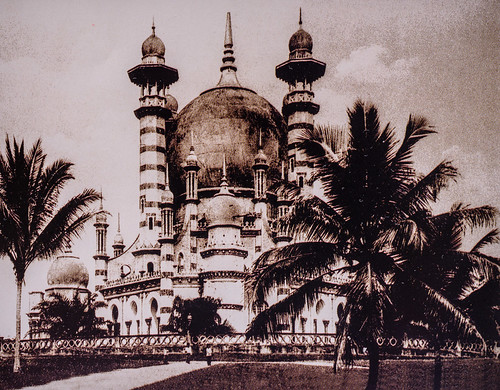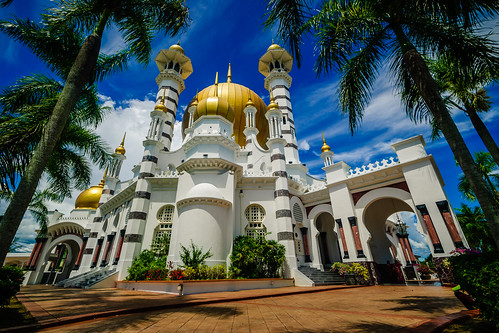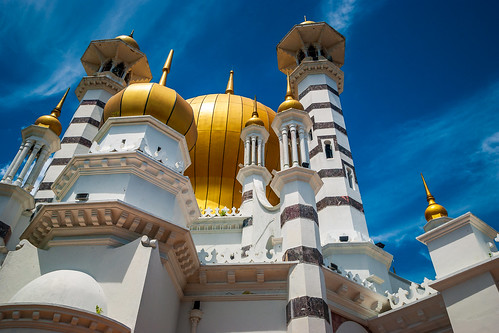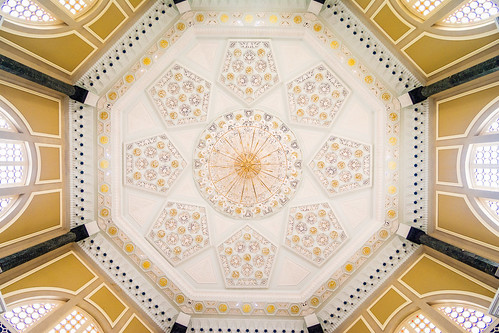The Ubudiah Mosque - A century-old iconic landmark of the royal town of Kuala Kangsar
If the Old Kuala Lumpur Railway Station is known as one of the most beautiful train stations in the world, the Ubudiah Mosque is regarded as one of the most beautiful mosques in the world. What do these two stately buildings have in common? They were both designed by the same prolific architect, Arthur Benison Hubback or more popularly known as A.B. Hubback. A.B. Hubback was also the architect for the Jamek Mosque of Kuala Lumpur (Completed in 1909). A.B. Hubback served as an architect for the FMS (Federal Malay States) Government since 1895 until 1914. In 1914 he returned to England with his family to join the 19th battalion of London Regiment as a Major in World War One. He had never returned to Malaya ever since although he survived in WWI. He died on 8 May 1948 at his home in Hertfordshire of heart failure.
The Ubudiah Mosque is one of the last three buildings he designed for the FMS Government. The other last two buildings are the FMS Railway Administration Office in Kuala Lumpur and the Ipoh Railway Station located in Ipoh. All these three buildings were completed in 1917 which means they turn 100 this year!
HISTORY OF THE MOSQUE
The Ubudiah Mosque was the brainchild of the 28th Sultan of Perak, Sultan Idris Murshidul’adzam Shah (1887-1916). Legend has it that following his return from England in 1911 (His Highness went to England to witness the coronation of King George V), His Highness the Sultan fell ill. He chose to stay in Port Dickson for respite. Whilst convalescing in Port Dickson, he made a vow to build a mosque in Bukit Chandan, Kuala Kangsar, if he fully recuperated as thanksgiving. After his return to Kuala Kangsar when his health greatly improved, His Highness commanded Colonel Huxley of the Public Works Department, Kuala Lumpur, to design a mosque which he wanted to build.
The Straits Times dated 30 September 1913 reported that a formal ceremony was held on Friday 26 September 1913 to celebrate the laying of the foundation stone of the Mosque performed by His Highness Sultan Idris Murshidul'adzam Shah. The event was attended by special dignitaries namely the High Commissioner, Sir Arthur Young and his wife; Chief Secretary to the Government, Sir Edward Brockman and his wife; the Raja Muda and many other important people in the government, including the architect, A.B. Huback as well as who's who in the society. The event also took place in conjunction with the week-long visit of the High Commissioner, Sir Arthur Young, to Perak. Just one day earlier His Highness the Sultan was conferred with the insignia of a Knight Grand Cross of Victorian Order by the High Commissioner, Sir Arthur Young at The Astana Negara, the Sultan's palace.
During the ceremony for the laying of the foundation stone, in his speech, as reported by The Straits Times, His Highness the Sultan did mention that the idea of the erection of a mosque originated in the time of Mr. St. George Caulfield (the Chief Engineer of Perak). At first the mosque proposed would cost some $50,000 and the fund was to be raised by contribution from the rakyat (people) of the state. This was not approved by the Government and accordingly High Highness proposed to build a mosque to cost $13,000 which would be considered a small mosque, and he offered to add $30,000 to the fund. His Highness did not bother to approach the Government as he thought the Government would not help him in this matter which was purely a Malay Muslim affair.
During Mr. Oliver Marks' acting Residency though, the Sultan received a letter of approval for the construction of the mosque from the Chief Secretary to Government saying that the Government would allocate $200,000.00 for the purpose. This only happened during the administration of the High Commissioner Sir Arthur Young who himself was equally interested in the building of the mosque.
Around that time the Sultan visited Singapore with the acting Resident of Perak, W.J.O. Hume. On that occasion His Highness visited the mosque in Johor which he was told to have cost $80,000 and was one of the finest mosques in the East.
When the Sultan later was presented with the plan of the mosque prepared by A.B. Hubback, His Highness was exceedingly pleased with the design but suggested an addition to the ceiling that would cost a very large sum. The High Commissioner however was pleased to give the extra sum necessary to carry out this addition so that when completed the mosque would be the finest in the East.
The site of the mosque, on Bukit Chandan, was chosen by His Highness himself, the British Resident (Mr. Watson) and the District Officer. In concluding his speech, His Highness said "As to your Excellency's assistance in regard to this mosque, I cannot speak. My heart is too full for words, and thanks would not be sufficient to express all I would say to you."
The construction commenced after the foundation stone was laid by the Sultan but the project experienced 2-year delay mainly caused by two events. Firstly, when the First World War broke out in Europe in 1914 the imported supply of Italian marble was significantly delayed as the ship had to travel via the Cape of Good Hope, South Africa. Secondly, another delay was said to have been caused by an elephant fight between Raja Chulan's elephant Kulop Gangga and Sultan Abdul Jalil's elephant Kulop Chandan. The fight of these two elephants has destroyed all the Italian marble which inevitably had to be ordered again from Italy.
The majestic mosque was eventually completed in late 1917 at a total cost of $224,000.00 Straits Dollars, a huge amount at that time for a mosque building. Sadly, Sultan Idris Murshidul'adzam Shah didn't get to see it completed as he passed away on 14 January 1916. The mosque was officially opened by the 29th Sultan of Perak, His Highness Sultan Abdul Jalil Karamatullah Shah (1916-1918) who succeeded his father, Sultan Idris Murshidul'adzam Shah.
The Ubudiah Mosque was designed in Indo-Saracenic style - the style imported directly from British India. It was the style of choice among British architects in India which was at its height of popularity at the end of 19th century until the second decade of the 20th century.
The Ubudiah Mosque is an octagon-shaped building and is linked to the ablution area at the rear of the building which is also in a form of smaller-sized octagon. In general, the plan was designed symmetrically. The design of this mosque is pretty unusual among any typical mosques in Malaysia.
The mosque proper was erected on an octagon base of 60 feet in diameter with a wide and imposing verandah all around making the whole octagon 96 feet in diameter. There is a large dome rising to a height of 140 feet tall which covers the main praying area. The main dome is surrounded by four minarets, each topped with a chhatri and a small dome, 126 ft in height and 16 turrets. The 4 minarets can be accessed up to the top via stairs whereas the other 16 turrets are just decorative elements.
In addition there are also horse-shoe and key-hole arches, another signature feature of Mughal and Indo-Saracenic style, surrounding the outdoor prayer hall
The volume of the building, including columns and walls, but excluding ablution area is approximately 7,888 square feet. The main praying area is approximately 3,420 square feet and could accommodate 427 people. The porch, utility room and chamber surrounding the main praying area is about 4,469 square feet. The foyer area could accommodate about 391 people. The ablution area which is located at the rear building has a huge octagonal pond and is connected to the main praying area.
It is learnt that the Ubudiah Mosque has never undergone any modification and renovation except for the large dome which has been replaced with aluminum dome as the original dome made of concrete was broken. Same goes to some of the small domes. The mosque had remained unchanged in its appearance from the day it was opened until 1991 when the renovation and upgrading work started.
According to Akitek Suria, the architectural firm appointed to produce the measured drawings of the Ubudiah Mosque, the renovation and upgrading plan had to obtain the consent from His Royal Highness, the 34th Sultan of Perak, Sultan Azlan Muhibuddin Shah on two conditions; not to demolish the original structure and additional structure must not be too prominent from the original design.
The chief objective of the renovation and upgrading was to increase the size of the praying area to accommodate more worshippers. In addition, the surrounding area of the mosque had also been improved, mainly the parking facilities and landscaping.
In ensuring the original architecture was maintained, the additional praying areas were built on the left and right on the rear part of the main building. The addition involved only outdoor praying area which was an extension to the existing outdoor praying area. This resulted in an extension of the outdoor praying area that finally measures about 4,463 square feet.
The renovation and upgrading work was completely finished in 1994. The upgrading of its capacity has enabled the mosque to accommodate a greater number of worshippers from 818 to 1,357 worshippers at any one time. Akitek Suria has done an excellent job in the design as the extended part was synchronized with the existing architecture so the authenticity of the original design could be maintained and the extension appears to be almost seamless just like what Almarhum Sultan Azlan Muhibbuddin Shah expected.
The Ubudiah Mosque is inextricably associated with the royal town of Kuala Kangsar and has become its iconic landmark. The Ubudiah Mosque besides being a place of worship for muslims it serves as a community centre to spread the teaching of Islam and hosts various other religious activities participated by the young and old.
Economically the mosque contributes to the growth of tourism industry in Kuala Kangsar in particular and Perak in general. The majestic mosque is one of the most popular tourist attractions among local and foreign tourists who visit Kuala Kangsar. Non-muslim visitors are allowed to visit the mosque in fact it is part of the Perak Mosque Trail open to muslim and non-muslim visitors. Non-muslims however are required to observe modest dress code otherwise robes are normally provided.
The Ubudiah Mosque is gazetted as historic built heritage and it is one of the 79 heritage sites in Perak protected under the National Heritage Act 2005 [Act 645].
Akitek Suria. (n.d.). Masjid Ubudiah. Retrieved from http://akiteksuria.com.my/islamic-masjid-ubudiah/
ExpatGo. (2014, August 13). The Man Behind Malaysia's Iconic Buildings: Arthur Benison Hubback. Retrieved from http://www.expatgo.com/my/2014/08/13/the-man-behind-malaysias-iconic-buildings-arthur-benison-hubback/
Mohamad Tajuddin Mohamad Rasdi. (2007). Mosque architecture in Malaysia : classification of styles and possible influence. Jurnal Alam Bina, 9 (3). 1-37. Retrieved from http://eprints.utm.my/1780/
Perak festivities: Commencement of the Abudiah Mosque. (1913, September 27). The Straits Times.
Perak festivities: The new mosque foundation stone. Laid by the Sultan. (1913, September 30). The Straits Times.
Perak in mourning. (1916, January 19). The Straits Times.
SembangKuala. (2009, December 11). A tale of two elephants – Masjid Ubudiah [Blog post]. Retrieved from https://sembangkuala.wordpress.com/2009/12/11/a-tale-of-two-elephants-masjid-ubudiah/
T. W. Yu., & Nur’Aini Adibah Baharum. (n.d). Ubudiah Mosque, Kuala Kangsar, Perak. Retrieved from http://www.academia.edu/3836280/Masjid_Ubudiah_Kuala_Kangsar_Perak_Malaysia
The Ubudiah Mosque is one of the last three buildings he designed for the FMS Government. The other last two buildings are the FMS Railway Administration Office in Kuala Lumpur and the Ipoh Railway Station located in Ipoh. All these three buildings were completed in 1917 which means they turn 100 this year!
 |
| The Ubudiah Mosque circa 1925 |
The Ubudiah Mosque was the brainchild of the 28th Sultan of Perak, Sultan Idris Murshidul’adzam Shah (1887-1916). Legend has it that following his return from England in 1911 (His Highness went to England to witness the coronation of King George V), His Highness the Sultan fell ill. He chose to stay in Port Dickson for respite. Whilst convalescing in Port Dickson, he made a vow to build a mosque in Bukit Chandan, Kuala Kangsar, if he fully recuperated as thanksgiving. After his return to Kuala Kangsar when his health greatly improved, His Highness commanded Colonel Huxley of the Public Works Department, Kuala Lumpur, to design a mosque which he wanted to build.
The Straits Times dated 30 September 1913 reported that a formal ceremony was held on Friday 26 September 1913 to celebrate the laying of the foundation stone of the Mosque performed by His Highness Sultan Idris Murshidul'adzam Shah. The event was attended by special dignitaries namely the High Commissioner, Sir Arthur Young and his wife; Chief Secretary to the Government, Sir Edward Brockman and his wife; the Raja Muda and many other important people in the government, including the architect, A.B. Huback as well as who's who in the society. The event also took place in conjunction with the week-long visit of the High Commissioner, Sir Arthur Young, to Perak. Just one day earlier His Highness the Sultan was conferred with the insignia of a Knight Grand Cross of Victorian Order by the High Commissioner, Sir Arthur Young at The Astana Negara, the Sultan's palace.
During the ceremony for the laying of the foundation stone, in his speech, as reported by The Straits Times, His Highness the Sultan did mention that the idea of the erection of a mosque originated in the time of Mr. St. George Caulfield (the Chief Engineer of Perak). At first the mosque proposed would cost some $50,000 and the fund was to be raised by contribution from the rakyat (people) of the state. This was not approved by the Government and accordingly High Highness proposed to build a mosque to cost $13,000 which would be considered a small mosque, and he offered to add $30,000 to the fund. His Highness did not bother to approach the Government as he thought the Government would not help him in this matter which was purely a Malay Muslim affair.
During Mr. Oliver Marks' acting Residency though, the Sultan received a letter of approval for the construction of the mosque from the Chief Secretary to Government saying that the Government would allocate $200,000.00 for the purpose. This only happened during the administration of the High Commissioner Sir Arthur Young who himself was equally interested in the building of the mosque.
Around that time the Sultan visited Singapore with the acting Resident of Perak, W.J.O. Hume. On that occasion His Highness visited the mosque in Johor which he was told to have cost $80,000 and was one of the finest mosques in the East.
When the Sultan later was presented with the plan of the mosque prepared by A.B. Hubback, His Highness was exceedingly pleased with the design but suggested an addition to the ceiling that would cost a very large sum. The High Commissioner however was pleased to give the extra sum necessary to carry out this addition so that when completed the mosque would be the finest in the East.
The site of the mosque, on Bukit Chandan, was chosen by His Highness himself, the British Resident (Mr. Watson) and the District Officer. In concluding his speech, His Highness said "As to your Excellency's assistance in regard to this mosque, I cannot speak. My heart is too full for words, and thanks would not be sufficient to express all I would say to you."
The construction commenced after the foundation stone was laid by the Sultan but the project experienced 2-year delay mainly caused by two events. Firstly, when the First World War broke out in Europe in 1914 the imported supply of Italian marble was significantly delayed as the ship had to travel via the Cape of Good Hope, South Africa. Secondly, another delay was said to have been caused by an elephant fight between Raja Chulan's elephant Kulop Gangga and Sultan Abdul Jalil's elephant Kulop Chandan. The fight of these two elephants has destroyed all the Italian marble which inevitably had to be ordered again from Italy.
The majestic mosque was eventually completed in late 1917 at a total cost of $224,000.00 Straits Dollars, a huge amount at that time for a mosque building. Sadly, Sultan Idris Murshidul'adzam Shah didn't get to see it completed as he passed away on 14 January 1916. The mosque was officially opened by the 29th Sultan of Perak, His Highness Sultan Abdul Jalil Karamatullah Shah (1916-1918) who succeeded his father, Sultan Idris Murshidul'adzam Shah.
 |
| The Ubudiah Mosque (South wing) |
ARCHITECTURAL FEATURES
The Ubudiah Mosque was designed in Indo-Saracenic style - the style imported directly from British India. It was the style of choice among British architects in India which was at its height of popularity at the end of 19th century until the second decade of the 20th century.
The Ubudiah Mosque is an octagon-shaped building and is linked to the ablution area at the rear of the building which is also in a form of smaller-sized octagon. In general, the plan was designed symmetrically. The design of this mosque is pretty unusual among any typical mosques in Malaysia.
The mosque proper was erected on an octagon base of 60 feet in diameter with a wide and imposing verandah all around making the whole octagon 96 feet in diameter. There is a large dome rising to a height of 140 feet tall which covers the main praying area. The main dome is surrounded by four minarets, each topped with a chhatri and a small dome, 126 ft in height and 16 turrets. The 4 minarets can be accessed up to the top via stairs whereas the other 16 turrets are just decorative elements.
In addition there are also horse-shoe and key-hole arches, another signature feature of Mughal and Indo-Saracenic style, surrounding the outdoor prayer hall
 |
| The mihrab of the mosque from outside faces the direction towards the Kaabah in Makkah. |
The volume of the building, including columns and walls, but excluding ablution area is approximately 7,888 square feet. The main praying area is approximately 3,420 square feet and could accommodate 427 people. The porch, utility room and chamber surrounding the main praying area is about 4,469 square feet. The foyer area could accommodate about 391 people. The ablution area which is located at the rear building has a huge octagonal pond and is connected to the main praying area.
 |
| The Ubudiah Mosque now |
RENOVATION AND UPGRADING IN 1991
It is learnt that the Ubudiah Mosque has never undergone any modification and renovation except for the large dome which has been replaced with aluminum dome as the original dome made of concrete was broken. Same goes to some of the small domes. The mosque had remained unchanged in its appearance from the day it was opened until 1991 when the renovation and upgrading work started.
According to Akitek Suria, the architectural firm appointed to produce the measured drawings of the Ubudiah Mosque, the renovation and upgrading plan had to obtain the consent from His Royal Highness, the 34th Sultan of Perak, Sultan Azlan Muhibuddin Shah on two conditions; not to demolish the original structure and additional structure must not be too prominent from the original design.
The chief objective of the renovation and upgrading was to increase the size of the praying area to accommodate more worshippers. In addition, the surrounding area of the mosque had also been improved, mainly the parking facilities and landscaping.
In ensuring the original architecture was maintained, the additional praying areas were built on the left and right on the rear part of the main building. The addition involved only outdoor praying area which was an extension to the existing outdoor praying area. This resulted in an extension of the outdoor praying area that finally measures about 4,463 square feet.
 |
| Floor plan: Before renovation and upgrading Image is reproduced from Akitek Suria website |
 |
| Floor plan: After renovation and upgrading Image is reproduced from Akitek Suria website |
 |
| Inside the mosque - the octagon-shaped central prayer hall |
 | |
|
The Ubudiah Mosque is inextricably associated with the royal town of Kuala Kangsar and has become its iconic landmark. The Ubudiah Mosque besides being a place of worship for muslims it serves as a community centre to spread the teaching of Islam and hosts various other religious activities participated by the young and old.
Economically the mosque contributes to the growth of tourism industry in Kuala Kangsar in particular and Perak in general. The majestic mosque is one of the most popular tourist attractions among local and foreign tourists who visit Kuala Kangsar. Non-muslim visitors are allowed to visit the mosque in fact it is part of the Perak Mosque Trail open to muslim and non-muslim visitors. Non-muslims however are required to observe modest dress code otherwise robes are normally provided.
The Ubudiah Mosque is gazetted as historic built heritage and it is one of the 79 heritage sites in Perak protected under the National Heritage Act 2005 [Act 645].
 |
| The rear view |
[Updated on 28 April 2023]
REFERENCES
Akitek Suria. (n.d.). Masjid Ubudiah. Retrieved from http://akiteksuria.com.my/islamic-masjid-ubudiah/
ExpatGo. (2014, August 13). The Man Behind Malaysia's Iconic Buildings: Arthur Benison Hubback. Retrieved from http://www.expatgo.com/my/2014/08/13/the-man-behind-malaysias-iconic-buildings-arthur-benison-hubback/
Perak festivities: Commencement of the Abudiah Mosque. (1913, September 27). The Straits Times.
Perak festivities: The new mosque foundation stone. Laid by the Sultan. (1913, September 30). The Straits Times.
Perak in mourning. (1916, January 19). The Straits Times.
SembangKuala. (2009, December 11). A tale of two elephants – Masjid Ubudiah [Blog post]. Retrieved from https://sembangkuala.wordpress.com/2009/12/11/a-tale-of-two-elephants-masjid-ubudiah/
T. W. Yu., & Nur’Aini Adibah Baharum. (n.d). Ubudiah Mosque, Kuala Kangsar, Perak. Retrieved from http://www.academia.edu/3836280/Masjid_Ubudiah_Kuala_Kangsar_Perak_Malaysia

Hi! I've been reading your weblog for some time now and finally got the
ReplyDeletebravery to go ahead and give you a shout out from Austin Texas!
Just wanted to mention keep up the fantastic job!
Thank you for visiting my blog. Please come again to find more articles on heritage buildings.
DeleteKuala Kangsar or Kuale was my born place.. Please come to Taiping also to have more heritage buildinngs including my own school - King Edward VII School (1883).
DeleteThanks for visiting my blog, the Legend. Yes I know KualaKKangsar and Taiping including Ipoh are steeped in history. Will pay them a visit whenever I have tje opportunity.
Delete